SSD + PCIe = ???
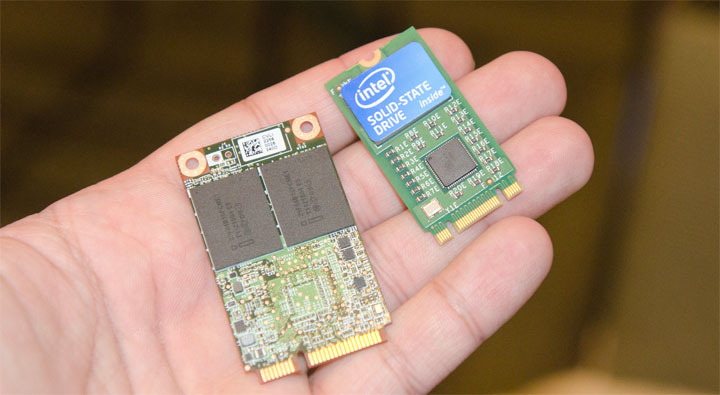
Intel is known for its consistent and active support for Solid State Drive technology, both in terms of creating the SSD devices themselves and in terms of developing an ecosystem for their use. It so happened that in this very ecosystem right now there have been some fundamental shifts associated primarily with the attraction of PCIe bus capabilities for storage needs. How significant their result will be, as usual, time will tell, however, the scale of innovations does not allow us to simply pass them by. So, in a few words about what awaits the SSD in the near future.

Forecasts of SSD market growth rate depending on volume. Source: Gartner
SSD + PCIe = NGFF
With the development of solid-state drives, they increasingly come up against the limitations associated with their functional progenitors - hard drives. This applies to physical dimensions (in fact, SSDs already “drop out” of the chassis of even the smallest HDDs), and data transfer interfaces. Apparently, the time has come to cut down the compatibility chains holding further progress, at least in those areas of digital technology where the old box has become too crunchy.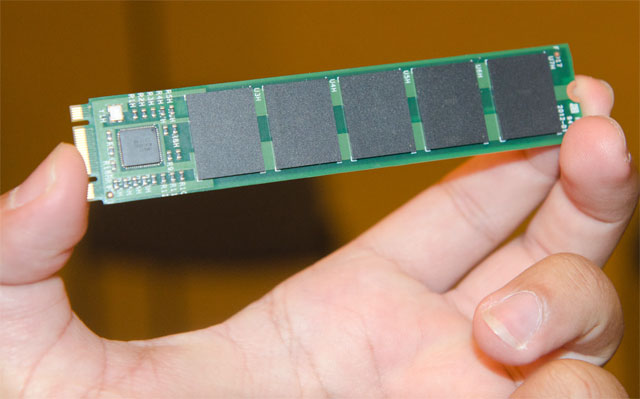
NGFF card size 22x110 mm
A fundamentally new form factor of drives, developed by Intel and effortlessly called NGFF (Next Generation Form Factor), offers a completely different approach to all of the above positions. From the point of view of physical arrangement, 5 standard sizes are standardized, with a length of 30 to 110 mm, a width of 22 mm and a thickness of 2-4 mm. As for the connection interface, two options are offered here: SATA / 2 PCIe lines (this is called Socket 2) or 4 PCIe lines (Socket 3). To distinguish the first from the second, the comb of the connector is made asymmetric with two recesses.
As you can see, the drive as a result turned out to be small (in the title picture it is on the palm on the right and mSATA on the left) and fast (up to 4 Gb / s in the case of Socket 3), which determines the main area of its application - ultrabooks and tablets. However, it can be used in server solutions, for example, in the form of caching devices, or even as a bus for peripherals. As follows from the same photo, NGFF drives exist in the form of real prototypes, but their mass production will begin after the appearance of the corresponding interfaces on the motherboard - additional logic for them is not required to be implemented.
SSD + PCIe = SATA Express || SFF-8639
Naturally, not only ultrabooks suffer from the low speed of the SATA bus, but also more efficient computers - desktops and servers. Apparently, for them, PCIe SSDs are currently the only real alternative to the currently used storage. How to introduce a new generation of storage systems, while maintaining the greatest possible compatibility with the old? After all, obviously, the replacement will not happen overnight, if only because of the cost of PCIe SSD. One solution is the SATA Express and SFF-8639 connectors.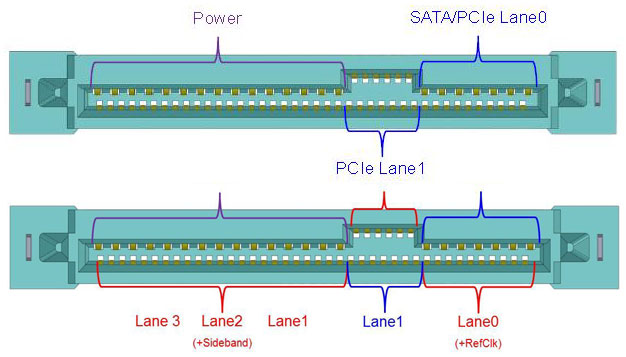
At the top of the picture is SATA Express, at the bottom is SFF-8639
Both of them, as can be seen from the figure, are combined SATA + PCIe solutions. SAS / SATA compatibility is complete - old hard drives will work without problems. For new ones, PCIe 2x in the SATA Express variant and PCIe 4x in the case of SFF-8639 are offered. In general, the segmentation is as follows: SATA Express is a transitional solution that gravitates to budget, SFF-8639 is a serious server option. In the first case, we have in addition only 2 PCIe lanes - this will not give us a stunning increase in speeds, however, it will still allow us to “cheer up” the storage. But 4x in SFF-8639 is already serious, although it is fraught with complication of the connection scheme, which means an increase in the cost of the entire system. Thus, the picture emerges approximately as follows: in conditions when the principal obstacles for dispersing the storage are practically removed,
SSD + PCIe = NVM Express
 If you look closely, there are more differences than similarities between SSDs and HDDs. More precisely, the similarities generally turn out only one thing - the function performed, and everything else - the differences: technological, ideological, etc. Based on this, it can be assumed that host controllers designed at one time for hard drives also need to be replaced. This is exactly what is happening now: the “warm tube” controllers are being replaced by a new PCIe SSD solution called the development community, which includes almost a hundred of the largest players in the digital industry, NVM (Non-volatile memory) Express.
If you look closely, there are more differences than similarities between SSDs and HDDs. More precisely, the similarities generally turn out only one thing - the function performed, and everything else - the differences: technological, ideological, etc. Based on this, it can be assumed that host controllers designed at one time for hard drives also need to be replaced. This is exactly what is happening now: the “warm tube” controllers are being replaced by a new PCIe SSD solution called the development community, which includes almost a hundred of the largest players in the digital industry, NVM (Non-volatile memory) Express. 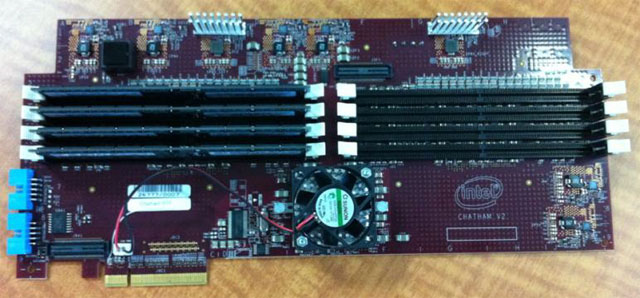
Prototype NVMe NVMe controller
allows SSD to reveal all its positive qualities. We list its main advantages:
- The “priority” has been significantly increased: up to 64,000 queues are supported, each with 64,000 teams;
- Concurrency and multithreading are radically improved; parallelization does not require locks and synchronization;
- Organized interrupt management, including MSI, in order to prevent the occurrence of bottlenecks in the path of data flows;
- And, most importantly - the delay introduced by the controller is radically reduced. If for SAS / SATA it was at least 6 ms, then the NVMe test sample already showed a result of 2.8 ms, which is more than two times less!
In the future, NVMe speed indicators will be significantly improved: the delay is no longer technologically real than 1 ms, and the developers of the standard are talking about the future 10 ms. A comparison of the performance of PCIe SSDs and NVMe SSDs is shown in the graph below.
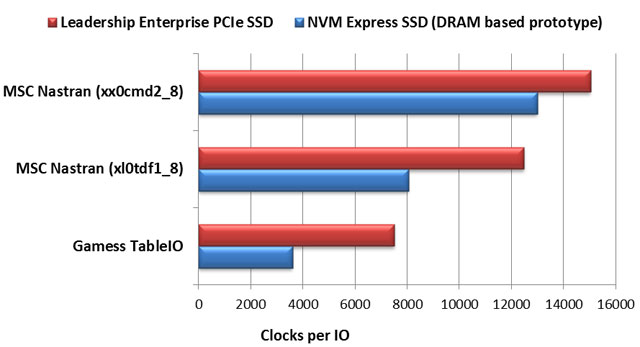
Currently published standard NVMe version 1.1; NVMe drivers are available for Linux, Windows, Solaris and VMWare, UEFI support is coming.
So, as we see, the process of implementing PCI Express technology in the life of storage devices has gone quite far - from a technological point of view. Now it’s up to the commercial component - how successful will be the launch of new standards on the market. In any case, there is no way back, you will have to choose something without fail.
